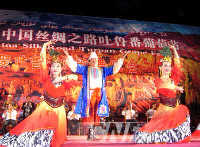|
Nazirkom Dance
( 2005-09-13 )
 A Nazirkom originated in the well-knownTurpanBasin and is popular in Shanshan, Toksun, and Hami. Some people in Urumqi also play it. The characteristic, ofNazikumuis humor. A Nazirkom originated in the well-knownTurpanBasin and is popular in Shanshan, Toksun, and Hami. Some people in Urumqi also play it. The characteristic, ofNazikumuis humor.
One saying holds that Nazir is a poor man's name, while kom is the sound of drums. Long, long ago Nazir created many dances satirizing the unscrupulousness of reactionary rulers as a way of showing his opposition to oppression by the ruling class. His dances were warmly received by the people. As time went on, the working people gradually developed them into a kind of folk dance and called itNazirkom.
Nazirkomis usually performed improvisational by men dancing in pairs. The performers do not sing but dance to the singing of a band and other people. When the performance begins, the dancers display their own skills separately. As the tempo quickens, a contest of skills starts. First, the two display customary feats, one mimicking the other's movements and both dancing in fine teamwork. Suddenly one dancer presents a new and difficult movement to challenge his partner who not only follows but creates something else. The spectators cheer on the performers to the rhythm of drums. Sometimes a silk flower or handkerchief is placed on the ground for the performers to pick up. One performer will challenge the other with particularly difficult maneuvers to pick it up. The performance reaches its climax and conclusion at this point amid people's cheers.
A walking step is most often used. Bending the knees slightly and relaxing the upper body, the performer walks about, changing postures or mimicking different characters. Light shoulder shrugs enhance the intimacy and humor of the dance.
With exaggeration and wit, Nazirkom imitates movements from daily life, such as rolling thread, stitching a shoe sole, and making dough and noodles. It also uses a great variety of squats, leaps, jumps and other movements.
The songs for accompaniment have special verses that in the past described the love of young people or exposed greedy and tyrannical landlords and local despots.
The music for Nazirkom is free and lively with striking tempi. When the dance comes to its end, there is only the rhythmic beating of drums and people's cheers.
Instruments include the ghij?k, rawap, tambur, tambourines, suona and iron drums of easternXinjiang. Sometimes only suona and iron drums and an extra-large drum, mellow in tone, are used. Veteran drummers can beat different tones to match the changing mood of the performers and enhance the effect of the dance.
|

